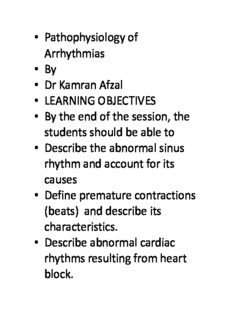
Pathophysiology of Arrhythmias • By • Dr Kamran Afzal • LEARNING OBJECTIVES • By the end of PDF
Preview Pathophysiology of Arrhythmias • By • Dr Kamran Afzal • LEARNING OBJECTIVES • By the end of
• Pathophysiology of Arrhythmias • By • Dr Kamran Afzal • LEARNING OBJECTIVES • By the end of the session, the students should be able to • Describe the abnormal sinus rhythm and account for its causes • Define premature contractions (beats) and describe its characteristics. • Describe abnormal cardiac rhythms resulting from heart block. • Describe the characteristics of atrial flutter and fibrillation • Relate all these abnormal rhythms to changes in ECG • Cardiac Arrhythmias ●An abnormality of the cardiac rhythm is called a cardiac arrhythmia. ● Arrhythmias may cause sudden death, syncope, heart failure, dizziness, palpitations or no symptoms at all. ● There are two main types of arrhythmia: bradycardia: the heart rate is slow (< 60 b.p.m). tachycardia: the heart rate is fast (> 100 b.p.m). • ACCELERATED AUTOMATICITY • It occurs due to increasing the rate of diastolic depolarization or changing the threshold potential. • Abnormal automaticity can occur in virtually all cardiac tissues and may initiate arrhythmias. • Such changes are thought to produce sinus tachycardia, escape rhythms and accelerated AV nodal (junctional) rhythms. • SVT SINUS TACHYARDIA • A condition in which the heart rate is 100-160/min • Symptoms may occur with rapid heart rates including; weakness, fatigue, dizziness, or palpitations. • Sinus tachycardia is often temporary, occurring under stresses from exercise, strong emotions, fever, dehydration, thyrotoxicosis, anemia and heart failure. • If necessary, beta-blockers may be used to slow the sinus rate, e.g. in hyperthyroidism • SINUS TACHYCARDIA • Atrial Arrhythmias Premature supra ventricular contractions or premature atrial contractions (PAC) • A condition in which an atrial pacemaker site above the ventricles sends out an electrical signal early. The ventricles are usually able to respond to this signal, but the result is an irregular heart rhythm. • PACs are common and may occur as the result of stimulants such as coffee, tea, alcohol, cigarettes, or medications. • Treatment is rarely necessary. • PAC • ATRIAL FLUTTER • Atrial Arrhythmias Atrial fibrillation (AF) - • A condition in which the electrical signals come from the atria at a very fast and erratic rate. The ventricles contract in an irregular manner because of the erratic signals coming from the atria. • The ECG shows normal but irregular QRS complexes, fine oscillations of the baseline (so- called fibrillation or f waves) and no P waves. • Common causes include CAD, valvular heart disease, hypertension, hyperthyroidism and others. In some patients no cause can be found 'lone' atrial fibrillation. • ATRIAL FIBRILLATION • Ventricular Tachyarrhythmias Ventricular tachyarrhythmias can be considered under the following headings: • life-threatening ventricular tachyarrhythmias (Sustained ventricular tachycardia and ventricular fibrillation) • torsades de pointes • normal heart ventricular tachycardia • non-sustained ventricular tachycardia • ventricular premature beats • Ventricular Arrhythmias Ventricular fibrillation (VF) • A condition in which many electrical signals are sent from the ventricles at a very fast and erratic rate. As a result, the ventricles are unable to fill with blood and pump. • This rhythm is life-threatening because there is no pulse and complete loss of consciousness. • The ECG shows shapeless, rapid oscillations and there is no hint of organized complexes • A person in VF requires prompt defibrillation to restore the normal rhythm and function of the heart. It may cause sudden cardiac death. Basic and advanced cardiac life support is needed • Survivors of these ventricular tachyarrhythmias are, in the absence of an identifiable reversible cause (e.g. acute myocardial infarction, severe metabolic disturbance), at high risk of sudden death. Implantable cardioverter-defibrillators (ICDs) are first-line therapy in the management of these patients • Ventricular Arrhythmias Torsades de pointes - • This is a type of short duration tachycardia that reverts to sinus rhythm spontaneously. • It may be due to: - Congenital - Electrolyte disorders e.g. hypokalemia, hypomagnesemia, hypocalcemia. - Drugs e.g. tricyclic antidepressant, class IA and III antiarrhythmics. • It may present with syncopal attacks and occasionally ventricular fibrillation. • QRS complexes are irregular and rapid that twist around the baseline. In between the spells of tachycardia the ECG show prolonged QT interval. • Treatment includes; correction of any electrolyte disturbances, stopping of causative drug, atrial or ventricular pacing, Magnesium sulphate 8 mmol (mg2+) over 10-15 min for acquired long QT, IV isoprenaline in acquired cases and B blockers in congenital types • Long-term management of acquired long QT syndrome involves avoidance of all drugs known to prolong the QT interval. Congenital long QT syndrome is generally treated by beta-blockade, left cardiac sympathetic denervation, and pacemaker therapy. Patients who remain symptomatic despite conventional therapy and those with a strong family history of sudden death usually need ICD therapy. • SINUS BRADYCARDIA • Bradycardias Sick sinus syndrome • A condition in which the sinus node sends out electrical signals either too slowly or too fast. There may be alternation between too- fast and too-slow rates. • This condition may cause symptoms if the rate becomes too
Description: